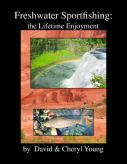Stream Characteristics
Streams are classified into three basic categories; spring creek, freestone, and tail water streams. Each shares unique features.
Spring Creek
A spring creek originates from an underground source - a spring. Because of their gentle gradients spring creeks are generally flat and smooth; they are found in valley floors rather than in steep canyons.
Freestone Streams
A Freestone streams’ water source is either snow melt or rainfall, relying upon precipitation for their flow volume. Freestones generally have steep gradients characterized by areas of rapid and fast currents.
Tail Water Streams
Tail water streams are found below dams and their water source flows from the reservoir. The outlet comes from controlled head gates which, releases water out from the bottom of the dam; as a result, the most dense and coldest water is released.
A Beginning Point
A beginning fisherman can learn much about fish habitat by fishing a small stream. First, select a stream with an abundance of naive fish; next, fish 100% of the stream.
Riffles
Riffles are places where the current picks up speed as it runs a relatively straight course over a gravelly or rocky bed. In freestone streams this rocky bed provides the most habitats for aquatic food production.
Current Seams
My favorite riffle lies are the current seams created by junctures of fast and slow flows. Here the fish enjoy the best of both worlds, a cushion lie with food drifting and depositing at its front door.
Pocket Water
Pocket waters are mini-resting lies located in the midst of water unsuitable to hold fish. Search for pockets in the middle of a fast riffle or in slow shallows; likewise, a snag caked with vegetation can provide protective cover even in the shallows.
Prime Lies
Prime lies provide fish the best habitat by providing protection, food, and rest. Prime lies become homes for the largest and the most dominant fish.
Deep Holes
Deep holes are usually resting lies but some can also be considered prime lies.
Resting Lies
Resting lies are cushioned places where fish can rest from the currents flows. Additional protective cover such as overhead vegetation or an increase in depth makes them more attractive for fish.
Structure
Structure is anything that furnishes holding cover. Logs and fallen trees enhance an area by providing cover.
Dead Water
Dead water refers to wide expanses of shallow muddy stream bed areas that are void of rooted plants. This habitat lacks the food production ability of a riffle.
Curvatures
Stream bed curvatures give origin to different types of fish holding places to form. The outside bends or greater curvatures receive the currents scouring actions.
Midstream
Fish may migrate to midstream areas when temperatures are high and oxygen content is low.
Foam Lines
Foam lines are the surface accumulations of floating matter. Here stillborn, emerging and drowned terrestrial insects are collected.
Eddy Lines
Eddy lines peel off from the rivers bends, points, and island heads; they provide comfortable lies for fish to hold. Their broken surfaces conceal feeding fish.
Edge Waters
Usually the shallows edge waters with little cover appear to be devoid of fish.
Lesser Curvatures
The slower and shallower inside flows of a river bend can be productive habitat.
Strategy
Once a beginning fly fisherman has experienced these various lies on a small stream he (she) is ready to fish the larger streams. Fish the larger stream as a group of small streams adjacent to each other.

© 2026 The Gale Group, Inc. All rights reserved.
© 2026 Perigee Learning LLC. All rights reserved.
LoveTheOutdoors.com is owned and operated by Advameg, Inc. © 2026 Advameg, Inc.
Camping Adventures • Dutch Oven Cooking • Sports Knots
Fly Tying • Freshwater Fishing • Fly Fishing

